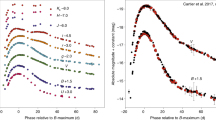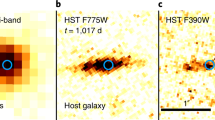Abstract
Type Ia supernovae result when carbon-oxygen white dwarfs in binary systems accrete mass from companion stars, reach a critical mass and explode. The near uniformity of their light curves makes these supernovae good ‘standard candles’ for measuring cosmic expansion1,2,3,4, but a correction must be applied to account for the fact that the brighter ones have broader light curves5. One-dimensional modelling, with a certain choice of parameters, can reproduce this general trend in the width–luminosity relation6,7,8; but the processes of ignition and detonation have recently been shown to be intrinsically asymmetric9,10,11,12,13, so parameterization must have its limits. Here we report multi-dimensional modelling of the explosion physics and radiative transfer, which reveals that the breaking of spherical symmetry is a critical factor in determining both the width–luminosity relation and the observed scatter about it. The deviation from spherical symmetry can also explain the finite polarization detected in the light from some supernovae14. The slope and normalization of the width–luminosity relation has a weak dependence on certain properties of the white dwarf progenitor, in particular the trace abundances of elements other than carbon and oxygen. Failing to correct for this effect could lead to systematic overestimates of up to 2 per cent in the distance to remote supernovae.
This is a preview of subscription content, access via your institution
Access options
Subscribe to this journal
Receive 51 print issues and online access
$199.00 per year
only $3.90 per issue
Buy this article
- Purchase on Springer Link
- Instant access to full article PDF
Prices may be subject to local taxes which are calculated during checkout




Similar content being viewed by others
References
Riess, A. G. et al. Observational evidence from supernovae for an accelerating universe and a cosmological constant. Astron. J. 116, 1009–1038 (1998)
Perlmutter, S. et al. Measurements of Ω and Λ from 42 high-redshift supernovae. Astrophys. J. 517, 565–586 (1999)
Astier, P. et al. The Supernova Legacy Survey: measurement of ΩM, Ωλ and w from the first year data set. Astron. Astrophys. 447, 31–48 (2006)
Wood-Vasey, W. M. et al. Observational constraints on the nature of dark energy: first cosmological results from the ESSENCE supernova survey. Astrophys. J. 666, 694–715 (2007)
Phillips, M. M. et al. The reddening-free decline rate versus luminosity relationship for Type IA supernovae. Astron. J. 118, 1766–1776 (1999)
Höflich, P. et al. Maximum brightness and postmaximum decline of light curves of Type IA supernovae: a comparison of theory and observations. Astrophys. J. 472, 81L–L84 (1996)
Pinto, P. A. & Eastman, R. G. The type Ia supernova width-luminosity relation. N. Astron. 6, 307–319 (2001)
Kasen, D. & Woosley, S. E. On the Type Ia supernova width luminosity relation. Astrophys. J. 656, 661–665 (2007)
Kuhlen, M., Woosley, S. E. & Glatzmaier, G. A. Carbon ignition in Type Ia supernovae. II. A three-dimensional numerical model. Astrophys. J. 640, 407–416 (2006)
Livne, E., Asida, S. M. & Hoeflich, P. On the sensitivity of deflagrations in a Chandrasekhar mass white dwarf to initial conditions. Astrophys. J. 632, 443–449 (2005)
Gamezo, V. N., Khokhlov, A. M. & Oran, E. S. Three-dimensional delayed-detonation model of Type Ia supernovae. Astrophys. J. 623, 337–346 (2005)
Reinecke, M., Hillebrandt, W. & Niemeyer, J. C. Three-dimensional simulations of Type Ia supernovae. Astron. Astrophys. 391, 1167–1172 (2002)
Livne, E. Delayed detonation at a single point in exploding white dwarfs. Astrophys. J. 527, L97–L100 (1999)
Wang, L. & Wheeler, J. C. Spectropolarimetry of supernovae. Annu. Rev. Astron. Astrophys. 46, 433–474 (2008)
Khokhlov, A. Delayed detonation model for type IA supernovae. Astron. Astrophys. 245, 114–128 (1991)
Hillebrandt, W. & Niemeyer, J. C. Type Ia supernova explosion models. Annu. Rev. Astron. Astrophys. 38, 191–230 (2000)
Hoflich, P. & Khokhlov, A. Explosion models for Type Ia supernovae: a comparison with observed light curves, distances, H0, and Qo. . Astrophys. J. 457, 500–528 (1996)
Höflich, P., Khokhlov, A. M. & Wheeler, J. C. Delayed detonation models for normal and subluminous type IA supernovae: absolute brightness, light curves, and molecule formation. Astrophys. J. 444, 831–847 (1995)
Kasen, D., Thomas, R. C. & Nugent, P. Time-dependent Monte Carlo techniques for the light curves, spectra, and polarization of supernovae. Astrophys. J. 651, 366–380 (2006)
Woosley, S. E. et al. Type Ia supernovae. Jour. Phys. Conf. Ser. 78, 012081 (2007)
Woosley, S. E. Type Ia supernovae: burning and detonation in the distributed regime. Astrophys. J. 668, 1109–1117 (2007)
Aspden, A. et al. Turbulence-flame interactions in Type Ia supernovae. Astrophys. J. 689, 1173–1185 (2008)
Woosley, S. E., Kerstein, A., Sankaran, V. & Röpke, F. Type Ia supernova: calculations of turbulent flames using the linear eddy model. Astrophys. J. (submitted); preprint at 〈http://www.arxiv.org/abs/0811.3610〉 (2008)
Stanishev, V. et al. SN 2003du, 480 days in the life of a normal Type Ia supernova. Astron. Astrophys. 469, 645–661 (2007)
Hoeflich, P. et al. Signature of electron capture in iron-rich ejecta of SN 2003du. Astrophys. J. 617, 1258–1266 (2004)
Branch, D., Fisher, A. & Nugent, P. On the relative frequencies of spectroscopically normal and peculiar Type Ia supernovae. Astron. J. 106, 2383–2391 (1993)
Krisciunas, K., Phillips, M. M. & Suntzeff, N. B. Hubble diagrams of Type Ia supernovae in the near-infrared. Astrophys. J. 602, L81–L84 (2004)
Hamuy, M. et al. The Hubble diagram of the Calan/Tololo Type Ia supernovae and the value of H0 . Astron. J. 112, 2398–2407 (1996)
Timmes, F. X., Brown, E. F. & Truran, J. W. On variations in the peak luminosity of supernovae. Astrophys. J. 590, L83–L86 (2003)
Howell, D. A. et al. The effect of progenitor age and metallicity on luminosity and 56Ni yield in Type Ia supernovae. Astrophys. J. 691, 661–671 (2009)
Acknowledgements
D.K. and S.E.W. thank the Max Planck Institute for Astrophysics for hospitality during a visit when much of this research was carried out. Support for this work was provided by the DOE SciDAC Program. Support for D.K. was provided by NASA through a Hubble fellowship grant awarded by the Space Telescope Science Institute, which is operated by the Association of Universities for Research in Astronomy, Inc., for NASA. The research of F.K.R. is supported through the Emmy Noether Program of the German Research Foundation. We are grateful for computer time provided by NERSC and ORNL through an INCITE award.
Author Contributions D.K. developed and ran the radiative transfer calculations used to generate synthetic light curves and spectra of the models, and performed analysis and comparison to observations. F.K.R. set up the initial model conditions and ran the series of hydrodynamical explosion models. S.E.W. provided insight into the parameterization of ignition, detonation and electron capture, and assisted with the analysis.
Author information
Authors and Affiliations
Corresponding author
Supplementary information
Supplementary Information
This file contains Supplementary Methods, Supplementary References and Supplementary Tables 1-2. (PDF 227 kb)
Rights and permissions
About this article
Cite this article
Kasen, D., Röpke, F. & Woosley, S. The diversity of type Ia supernovae from broken symmetries. Nature 460, 869–872 (2009). https://doi.org/10.1038/nature08256
Received:
Accepted:
Issue Date:
DOI: https://doi.org/10.1038/nature08256
This article is cited by
-
Models for Type Ia Supernovae and Related Astrophysical Transients
Space Science Reviews (2018)
-
Astronomical Distance Determination in the Space Age
Space Science Reviews (2018)
Comments
By submitting a comment you agree to abide by our Terms and Community Guidelines. If you find something abusive or that does not comply with our terms or guidelines please flag it as inappropriate.



